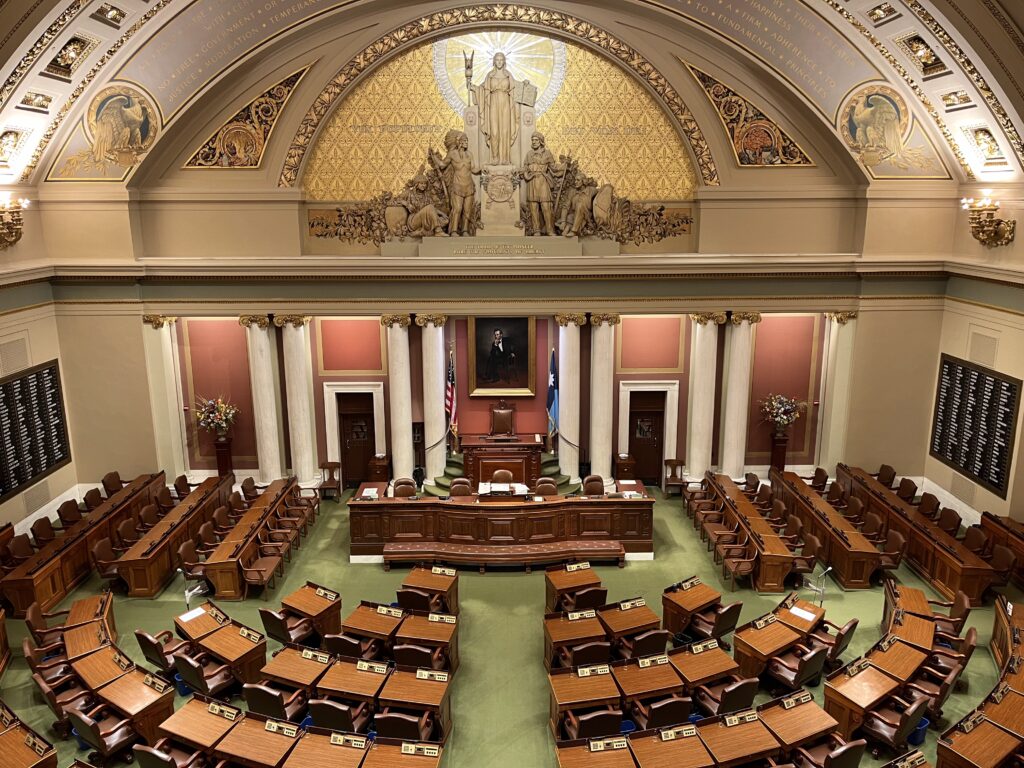Photos sourced from Library of Congress- Ellis Island has been called the “Island of Hope” and the “Island of Tears”, showcasing the United State’s complex history as a metling pot nation.
By: Catherine Synstelien, Maribel Monjaras-Rodriguez, Neil Roy, Zhaolan Wang
*Note* interviewees Zoey F. and Mahmoud A. were granted partial anonymity to ensure protection of their immigration status
For many immigrants in Minnesota, the pursuit of the American Dream — the ideal that equality of opportunity allows anyone to achieve their highest aspirations — remains burdened by economic hardship, trauma, and systemic barriers.
Over 482,000 immigrants make up 8.4% of the state’s population, according to the American Immigration Council. Immigrants fuel key industries, account for nearly 11% of the workforce and contribute billions in taxes and consumer spending.
Data from American Immigration Council
Behavior Interventionist and McNair Scholar, Katherine Montepeque Gonzalez, said despite these contributions achieving the American Dream remains elusive for many.
“Immigrants face trauma not just before and during migration, but long after they settle in the U.S.,” said Gonzalez. “The challenges don’t end at the border.”
MN State Representative Sandra Feist, an immigration lawyer and advocate for immigration rights, said the American Dream has changed dramatically for those seeking it today.
“The way that people used to come here just doesn’t exist anymore,” Feist said. “People spend many years waiting and it seems like they have closed the doors for humanitarian immigration.”

History of U.S. Immigration Timeline (1980-2025)
For some, the American Dream is first learned through popular culture. Zoey F., a young Chinese immigrant, said her first experience with the American dream came from a school showing of The Pursuit of Happiness.
Zoey said after she watched the movie, she and her family could have a better life in the United States.
“We got an opportunity to move to the U.S. at that time,” Zoey said. “My family is mostly for my sister and my education, so we decided to move here.”
At the University of Minnesota, Egyptian student Mahmoud A. said his experience as an international student did not change his prior view of the American Dream.
“I haven’t believed in it before I came here, and I certainly don’t believe in it now because there’s nothing that changed my view,” he said. “It depends on the circumstances, just coincidence and luck.”
Minnesota’s immigrant communities, particularly those from countries like Somalia, Mexico and Ethiopia, contribute significantly to the workforce, according to the American Immigration Council. Still, barriers like diploma recognition, language access, and narrow immigration pathways often hinder stability and advancement.
Beyond immigration delays, Feist pointed to professional barriers that prevent immigrants from fully contributing their skills.
“The licensure barriers are very difficult,” she said. “If you’re a dentist in Syria you should be a dentist here but that’s often not the case.”
Data from American Immigration Council
Undocumented immigrants — about 17% of Minnesota’s foreign-born population — face heightened vulnerability. Gonzalez said that detention centers, often used to house those awaiting immigration decisions, can inflict lasting psychological harm.
“The trauma is compounded by poor detention conditions like sleep deprivation, solitary confinement, and untreated mental health crises,” Gonzalez said. “Children and adults alike carry invisible scars long after release.”
Feist warned that current federal policies risk deterring future generations of immigrants.
“With the way that the new administration is going, I think that people will no longer want to come here,” Feist said. “It looks like they are cancelling all student visas at Universities they hate.”
At least 1,500 student visas were canceled in the last month due to the SEVIS- Student and Exchange Visitor Information System- record terminations conducted by Immigration and Customs Enforcement, according to NPR. ICE cited “otherwise failing to maintain status” as the justification for termination but many stated they were in good standing.
On April 25, after 50 judges ordered the restoration of the SEVIS records, the Department of Justice said that they planned to restore hundreds of the terminated student records, according to NPR.
Feist also said that many Minnesotans underestimate the complexity of the few and narrow immigration pathways today.
“These people are law abiding and have skills that we need but the laws are so atrophied,” Feist said. “We haven’t updated our laws since 1990 and they have no relation with the world we live in today.”
Despite these challenges, Zoey said immigrants continue to build futures for themselves and their families. She said she continues to seek prosperity despite the current political climate.
“I learned that I want to be my strong support for my family,” Zoey said. “For this experience, I have met so many friends who changed my life, who helped me to support me understand myself during the process.”
Zoey also said her vision of the American Dream differs from her parents.
“Just being more subsist to make friends and to make myself better,” she said. “I am more focused on myself, but for my parents, their goal is to help me and my sister receive a better education and to have a new opportunity.”
Still, without reforms to immigration policies and better support systems, Gonzalez said the American Dream will remain out of reach for many.
“Immigrants come to the U.S. with hope,” Gonzalez said. “But too often, the very system that promises opportunity ends up betraying that dream.”